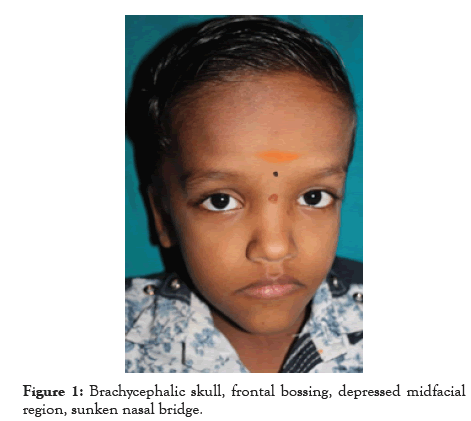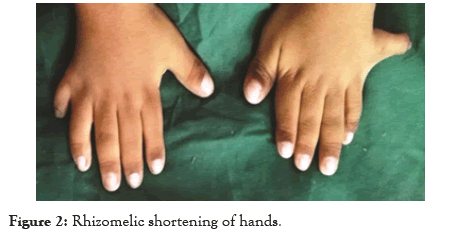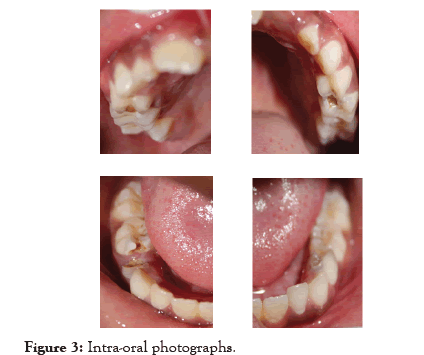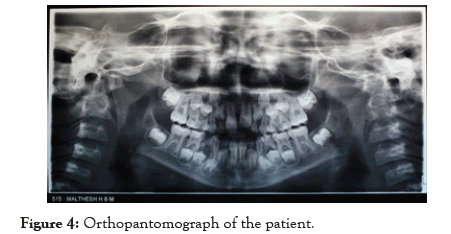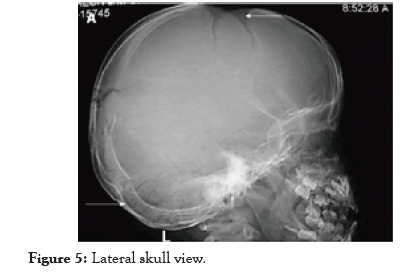ISSN : 2393-8854
Global Journal of Research and Review
Typical Reason of Dwarfism: Achondroplasia
Priyanka Mayer*
Department of Pediatrics, Kasturba Medical College, Mangalore, Karnataka, India
- *Corresponding Author:
- Mayer P
Department of Pediatrics,
Kasturba Medical College,
Mangalore,
Karnataka,
India,
E-mail: priyankamayer1994@gmail.com
Received Date: January 04, 2021; Accepted Date: January 18, 2021; Published Date: January 25, 2021
Citation: Mayer P (2021) Typical Reason of Dwarfism: Achondroplasia. Glob J Res Rev Vol.8 No.1: 56
Abstract
Achondroplasia is taken into consideration as the most typical reason of dwarfism that is inherited as an autosomal dominant trait. It has an incidence of one in 15,000 to 40,000 stay births. This genetic disease normally manifests at delivery as a disproportionately enlarged head in assessment to the body, and a discounted length of palms and legs. Here, we document a case of an 8yr male patient, with functions of achondroplasia, who stated to us with a loss of eruption of higher the front teeth for the reason that beyond 1 year.
Introduction
Achondroplasia is a Disorder of Bone growth which is the basic reason for Dwarfisam. It prevents the changing of Cartilage to Bone. It is an Autosomal Dominant Genetic Disorder and was discovered by Jhon Wasmuth. The basic reason for cause of this Achondroplasia was Mutation of Fibroblast Growth factor receptor-3 (FGFR3) gene on chromosome 4. This Case study gives a good Summery and understanding of Typical Reason of Dwarfism which is termed as Achondroplasia.
Case Study
An eight-year-vintage Indian male child, pronounced to the Department of Oral Medicine and Radiology, with a criticism of lacking higher the front teeth for the reason that beyond 1 year. Patient’s father discovered, that there have been no records of trauma to the region.
Natal and post-natal records discovered that affected person become added through naturalis at 32 weeks and 6 days of gestation. His beginning weight become 2.1 kilograms and top become 10 inches. His father additionally discovered that affected person had a massive head and brief limbs on the time of beginning and had behind schedule milestones which includes crawling, on foot and speech.
The Extra-Oral capabilities cited in this example had been macrocephaly (head circumference become 56.8 cm), disproportionately brief stature, rhizomelic shortening of the palms and legs (Figures 1 and 2), barriers in joint movement, lengthy face, frontal bossing, convex profile, midfacial hypoplasia, saddle nose, trident arms and polydactyl. Despite this dwarf like appearance, the kid had ordinary intelligence. On intraoral examination (Figure 3), blended dentition become gift with the maxillary and mandibular arch, besides for lacking everlasting maxillary left critical incisor, and excessive frenal attachment had been additionally observed. Multiple enamel had been discovered to be carious, which include a grossly destructed mandibular proper first deciduous molar.
Orthopantomograph confirmed (Figure 4), ordinary skeletal systems and behind schedule eruption with appreciate to the maxillary left everlasting critical incisor and a persistent dentoalveolar abscess irt mandibular proper first deciduous molar.
Cephalometric evaluation of the lateral cranium radiograph (Figure 5) discovered a posteriorly placed maxilla relative to the nasion, a brief cranial base, a ordinary mandible, a reduced higher facial top, an anteriorly tipped up palatal plane, and a skeletal magnificence III jaw relation among the maxilla and mandible. A unique genetic evaluation discovered, the presence of heterozygous mutation in 1138 G>A loci of the Fibroblast Growth Factor Receptor 3 (FGFR3) gene. Mutation on this gene reasons a extrade with the series of amino acids from glycine to arginine, which in flip reasons an inhibition with the increase of cartilage cells and disturbances in bone increase affecting the cranium, backbone and tubular bone.
As for the, lacking maxillary left critical incisor, it confirmed a ordinary eruption sample in orthopantomograph. Hence, no remedy becomes deliberate for the same. Pulpectomy observed with the aid of using stainless-steel crown become deliberate for the mandibular proper first deciduous molar.
Discussion
Achondroplasia is the maximum not unusualplace shape of dwarfism in humans. It happens with a frequency of one in 15- 25,000 and 80% of instances are sporadic. It is an autosomal dominant genetic ailment that has 100% penetrance [1].
The achondroplasia phenotype has been identified for hundreds of years, as evidenced with the artifacts of many one-of-a-kind cultures [2] and stays the maximum readily recognizable of the dwarfing disorders. The time period appears to were first used with the 19th century, and, even as the primary capabilities have been defined shortly thereafter [3], it regularly was used as a regularly occurring descriptor of all brief-limb dwarfing disorders. Detailed and precise radiologic and scientific capabilities have been cautiously delineated with the aid of using Langer et al. [4]. It stays the satisfactory characterised and maximum studied of the masses of dwarfing skeletal dysplasias.
Mutations with the FGFR3 gene cause achondroplasia. The FGFR3 gene affords commands for creating a protein this is concerned with the development and preservation of bone and mind tissue. This precise mutation is at least 500 or 1000-fold extra common than expected [5]. FGFR3 is certainly considered one among 4 fibroblast boom factor receptors in humans. All are mobileular floor receptors that have an effect on cellular proliferation. FGFR3 is produced from an extracellular area with three immunoglobulin-like regions, a transmembrane area and an intracellular tyrosine kinase [6].
Clinical Features-Patients with achondroplasia may also happen someone or extra of those scientific capabilities:
• Small stature, Short limbs and rhizomelic disproportion of fingers and limbs. Often there are redundant pores and skin folds of the higher fingers and the thighs.
• Macrocephaly: Head length is typically massive at delivery and stays so all through life. Variable frontal and parietal bossing (prominence and bumpy protuberance) is typically present. The anterior fontanel is regularly massive in infancy and can persist to as past due as five or 6 years of age.
• Midfacial retrusion: Underdevelopment of cartilaginous bones of the face bring about pulling down of the complete midface and a flat nasal bridge, a brief nasal backbone and anteversion of the nose. Small chest and overly compliant ribs. This consequences in paradoxical motion with inspiration, that is regularly misinterpreted as being retractions reflecting breathing distress.
• Thoracolumbar kyphosis and Lumbar hyperlordosis. Exaggerated lordosis (“swayback”) arises while strolling begins.
• Limited elbow extension. Unlike maximum other joints, the elbows are stiff and can, with age, emerge as steadily stiffer.
• Short palms and trident configuration of the fingers.
• Hypermobile hips and knees.
• Bowing of the mesial phase of the legs. Bowing isn't congenital. It most usually arises in early formative years and can development at unpredictable fee and quantity till boom is completed.
• Hypotonia.
Craniofacial Manifestations- may be behind schedule in achondroplastic youngsters because of altered bone boom. Because of hypoplasia of midfacial systems malocclusion is not unusualplace. In addition to maxillary hypoplasia, there's relative overgrowth of the mandible; it's far unsure whether or not mandibular boom is itself regular or diminished however much less so than is the diminishment of maxillary boom. Early orthodontic evaluation ought to be taken into consideration in such youngsters to strive the opportunity of interceptive orthodontics.
Management
Considerable development has been made all through the past two decades in information FGFR3-associated issues as nicely in growing a motive for powerful healing techniques to deal with FGFR3-related bone increase defects. Many nonsurgical techniques aimed toward decreasing excessive activation of FGFR3 had been proposed to stimulate linear bone increase in sufferers with Achondroplasia, had been tried [1].
Conclusion
A great deal has been found out approximately the outcomes of achondroplasia on folks that are affected. Nonetheless, the excellent of care that may be furnished is compromised through the restricted excellent of the proof that is, for the maximum part, available. Dentists treating those youngsters have to have the ability to understand those capabilities and its headaches as dental control is confined through sensible issues related to this disease.
References
- Ornitz DM, Legeai-Mallet L (2017) Achondroplasia: Development, pathogenesis, and therapy. Dev Dyn 246:291-309
- Pauli RM (2019) Achondroplasia: A comprehensive clinical review. Orphanet J of Rare Dis 14.
- Baujat G, Legeai-Mallet L, Finidori G, Cormier-Daire V, Le Merrer M (2008) Achondroplasia. Best Pract Res Clin Rheumatol 22:3-18.
- Langer LO, Baumann PA, Gorlin RJ (1967) Achondroplasia. Am J Roentgenol 100:12-26.
- Eswarakumar VP, Lax I, Schlessinger J (2005) Cellular signaling by fibroblast growth factor receptors. Cytokine Growth Factor Rev 16:139-49.
- Goriely A, Wilkie AOM (2012) Paternal age effect mutations and selfish spermatogonial selection: Causes and consequences for human disease. Am J Hum Genet 90:175-200.
Open Access Journals
- Aquaculture & Veterinary Science
- Chemistry & Chemical Sciences
- Clinical Sciences
- Engineering
- General Science
- Genetics & Molecular Biology
- Health Care & Nursing
- Immunology & Microbiology
- Materials Science
- Mathematics & Physics
- Medical Sciences
- Neurology & Psychiatry
- Oncology & Cancer Science
- Pharmaceutical Sciences
